AMMAN — Astride century-old tracks that cut
through the modern metropolis of
Amman, a historic train blared a horn to
announce its departure. That sound spurred families bearing bags of food, pots
of coffee, coolers of soda, grills, hookahs, and lots of children into action,
scrambling up iron ladders to settle into the train’s wooden cars.
اضافة اعلان
But the party had already begun in car No. 9, where
a group of women and dozens of children were clapping along to an Arabic pop
song blasting from a battery-powered speaker with flashing disco lights.
The train blew its horn again and lurched to life,
jolting the partyers, who laughed as they righted themselves and burst into
applause at the sight of the world outside their windows slipping by.
So began a recent trip from Amman, Jordan’s capital,
on the last functioning strip of the original
Hejaz Railway, the most iconic
train in the Middle East.
Built by the Ottomans at the dawn of the 20th
century, blown up by Lawrence of Arabia and Arab fighters during World War I,
and used as a nostalgic backdrop in “The Mummy Returns” and in syrupy
Arabic music videos about forlorn lovers, the railway is a relic of the bygone dream
of regional unity before wars, borders, and more advanced modes of
transportation rendered its services obsolete.
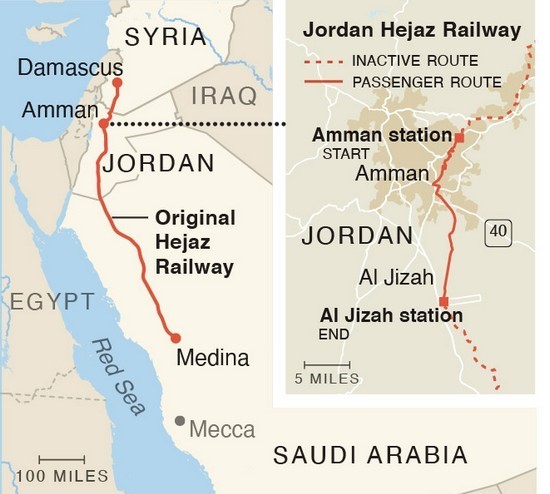 The antique Hejaz Railway in Jordan is a relic of that bygone dream before wars, borders, and travel by air.
The antique Hejaz Railway in Jordan is a relic of that bygone dream before wars, borders, and travel by air.
A pet project of
Sultan Abdul Hamid II, the railway was completed in 1908 and ran for more than
800 miles through the mountains and deserts of the Levant and Arabia to ferry
pilgrims from
Damascus to Medina, one of Islam’s holiest cities, now in Saudi
Arabia. From there, they would travel on by other means to Mecca, the focus of
the pilgrimage.
Secondary lines ran to Haifa — now a major Israeli
city — and Beirut, the Lebanese capital on the Mediterranean coast. And plans
were in place to connect the line to Constantinople, the Ottoman capital, in
the north and all the way to Mecca in the south, stitching together a large
swath of the Ottoman Empire.
But six years after the train’s first triumphant
arrival in Medina on September 1, 1908, World War I broke out, leading to the
dismemberment of the empire and new borders. The Haifa line went out of service
around 1948, when Israel’s creation left it at war with its Arab neighbors. The
Beirut line stopped around the start of Lebanon’s 15-year civil war in 1975.
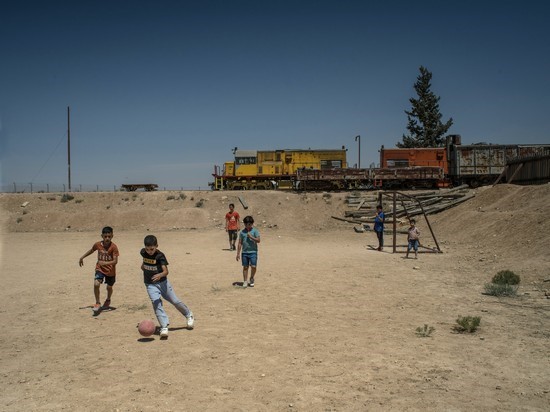 Children play soccer during a lunch break, in Amman, Jordan’s capital, on June 4, 2022. Tuckered out, many children slept on the return trip.
Children play soccer during a lunch break, in Amman, Jordan’s capital, on June 4, 2022. Tuckered out, many children slept on the return trip.
Now, the narrow-gauge tracks remain, but the
railway’s mainline crosses three countries — Syria, Jordan, and
Saudi Arabia —
whose leaders have shown little interest in reviving the project.
Saudi Arabia welcomes pilgrims bound for
Mecca at a
fancy airport terminal and shuttles them around the holy sites on a modern
high-speed train. Rail traffic in Syria screeched to a halt after the outbreak
of its civil war in 2011.
That leaves only Jordan, which now offers 80km
leisure trips from Amman to the Al-Jizah station south of town and back, with a
four-hour lunch break in the middle.
It is a trip that does not go anywhere anyone needs
to be, so the riders come for the journey — and a big dose of nostalgia.
“I love trains because they remind me of
Agatha Christie novels,” said Islam Dawoud, 36, sinking into her red plush chair and
gazing out the window.
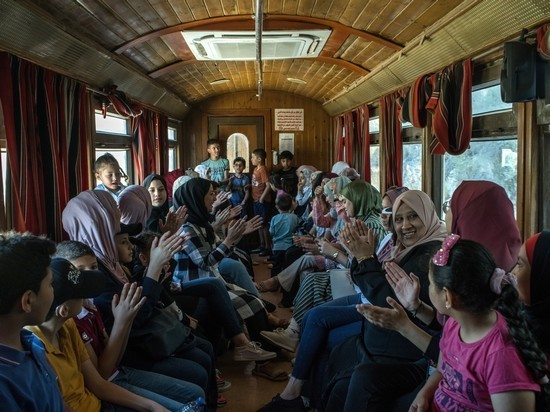 Women and children clap along to an Arabic pop song in train car No. 9 at the start of the trip from Amman, Jordan’s capital, on June 4, 2022.
Women and children clap along to an Arabic pop song in train car No. 9 at the start of the trip from Amman, Jordan’s capital, on June 4, 2022.
She first rode the train as a schoolgirl, she said.
There was no air conditioning and the cars were dusty, but the memory stuck
with her nevertheless.
“What I loved was that the window was open and I
could put my head out,” she said.
The train departs in the morning from the Amman
station, a handsome, ivy-draped stone building from the first decade of the
20th century.
In the train yard were two original but refurbished
passenger cars, including the one that Abdullah I, great-grandfather of
Jordan’s current king, rode into the city in 1921, when he became the
territory’s ruler.
Parked nearby were seven giant black steam engines
with red wheels. They all still work but are used only on special occasions
because they take hours to fire up and are heavy polluters, said Nader Malkawi,
a railway official and train conductor who organizes the trips.
On its recent journey, the train was pulled by two
diesel-electric locomotives built in 1976. Some components of the cars were
original, but most were Japanese tanker cars that Jordan had converted to
wooden passenger cars in 2005.
That upgrade also added electricity for lighting, as
well as air conditioning and the speakers that piped Arabic pop music into the
cars throughout the trip.
Railway buffs in Jordan have another option: A line
that carried phosphates to
Aqaba, Jordan’s only coastal city, stopped running
in 2018, Malkawi said. But that line passes though Jordan’s scenic
Wadi Rum,
where tourists can take short rides on it and sometimes watch a band of locals
on horseback and dressed in period costumes reenact Bedouin attacks.
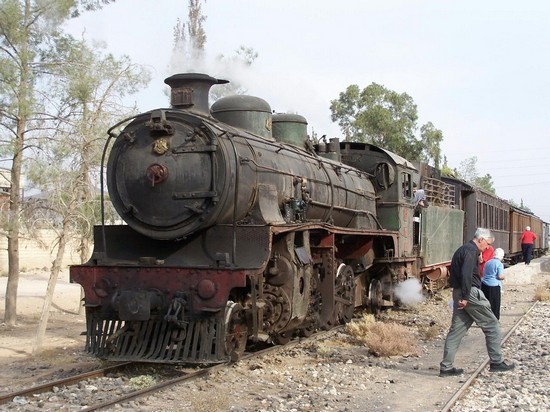
The trips from Amman are longer but without the
theatrics. Tickets cost $7 for riders 12 and older, and less for children.
Those younger than three ride free. The train has a snack car as well as a VIP
car with plush seats, burgundy curtains, and a crown on the door.
The trip was different three decades ago, said one
passenger, Fidaa Abu Safia, 38, who first rode along the same tracks when she
was six.
There was no music. The wooden seats were
uncomfortable and it was hot, she said, but the train still felt magical. She
recalled passing trees with yellow blossoms that fell into the windows.
“It was the best trip of my life,” Abu Safia said.
As the upgraded train wound through the cinder block
sprawl of southern Amman, there were no blossoms to see. Instead, many
industrial warehouses, junkyards, and mechanic shops popped into view, along
with a gargantuan failed shopping mall and lots of garbage strewed along the
tracks.
The dearth of scenic vistas did not bother Hussam
Al-Khatib, a soldier, who had learned of the trip on Facebook and brought his
wife and their three sons. All were first-time train riders.
He said that Jordan did not have great public
transportation and that the views were not stellar, but he felt it was
important for Jordanians to know their country.
“We are proud of Jordan’s sights,” he said.
Outside Amman, the landscape opened up, with golden
wheat fields, greenhouses full of tomatoes and eggplants, flocks of sheep, the
occasional herd of camels, and barking dogs chasing the train.
Before the station in
Al-Jizah, where the passengers
stopped for lunch, the train passed Amman’s international airport, from which
jets took off overhead, roaring reminders of the technologies that had reduced
the train from a cutting-edge conveyance to a historical curiosity.
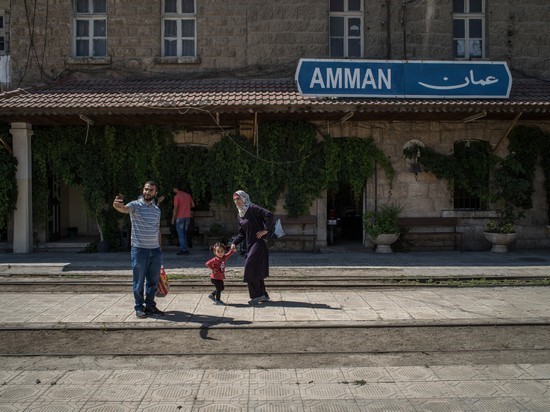
At the station,
as workers moved the engines from one end of the train to the other for the
return trip, families claimed shady spots under
cypress and eucalyptus trees
and fired up charcoal grills and hookahs while their children ran around a
sandy playground and climbed on abandoned boxcars.
Later, the train blew its horn and the riders
returned, snapping photographs alongside the cars.
The return trip was quieter, with the sun, the
creaking cars, and the steady click-clack of the train lulling many of the
children, and some of the adults, to sleep.
But Heba Al-Shishan refused to miss any of it.
Smiling and snapping photographs as she took in the landscape, she, too,
recalled a childhood journey. On that ride, the train had to stop because
nomads had tethered sheep to the tracks and had to move them before the trip
could proceed.
“These are experiences I will never forget,” Shishan said.
Read more Around Jordan
Jordan News



